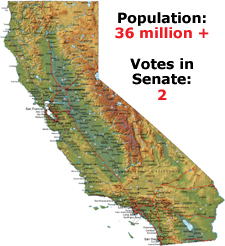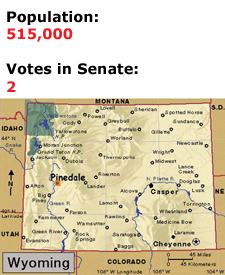 You’ve heard (way too many times) the facile comparison between legislating and making sausage. It’s the kind of analogy that obscures the spectacular level of dysfunction now most impressively on display in the U.S. Senate. This institution has always been a problem with respect to the popular will, but under the current circumstances, the “world’s greatest deliberative body” has become not the cooling saucer of democracy but a dousing bucket of cold water. There is, of course, no question that the Senate is an extremely undemocratic institution, according the same number of votes and, therefore, the same political power to every state, whether it is home to 36 million (California) or 500,000 (Wyoming). Even if the chamber’s arcane rules allowed for voting on a majority-rule basis, it would be intrinsically unfair to larger population centers – i.e. the kinds of communities that most rely on social programs administered by the federal government.
You’ve heard (way too many times) the facile comparison between legislating and making sausage. It’s the kind of analogy that obscures the spectacular level of dysfunction now most impressively on display in the U.S. Senate. This institution has always been a problem with respect to the popular will, but under the current circumstances, the “world’s greatest deliberative body” has become not the cooling saucer of democracy but a dousing bucket of cold water. There is, of course, no question that the Senate is an extremely undemocratic institution, according the same number of votes and, therefore, the same political power to every state, whether it is home to 36 million (California) or 500,000 (Wyoming). Even if the chamber’s arcane rules allowed for voting on a majority-rule basis, it would be intrinsically unfair to larger population centers – i.e. the kinds of communities that most rely on social programs administered by the federal government.
But it’s far more unfair than that. For one thing, under the rules of the senate, a single member can hold up important legislation and key appointments. And in a political moment such as the one we find ourselves in now, any piece of legislation must repeatedly achieve a 60-vote super majority to gain passage. If you combine the populations of all of the states that have 2 Democratic (or Dem-caucusing independent) Senators, that alone makes up more than half of the U.S. population. Those 158 + million people are represented by 44 out of 100 members. A bare majority in the Senate would require votes representing a far greater number than that. That in itself is remarkably limiting, given the important constitutional role the Senate plays in making and shaping legislation, ratifying treaties, confirming presidential appointees, and so on. When you combine that with the additional requirement that legislation – any legislation – must garner 60 votes to gain passage, this is a significant veto power over the will of the majority.
 The current situation in the Senate is such that the filibuster is a constant, a given. So the notion that any meaningful action will take place within its walls – landmark legislation supported by a broad swath of the American public – is beyond contemplation. It would be difficult under majoritarian voting procedures, but the 60-vote minimum requires the inclusion of so many watery centrists and “Democrats in name only” that the guts are always ripped out of whatever is under consideration. This is certainly true of the health insurance reform legislation. This will also be true of any other major initiative. After this year’s experience, I am doubtful that they will even attempt to take up the Employee Free Choice Act… and I’m certain that, if they did, the Ben Nelsons (representing 1.8 million), Mary Landrieus (representing 4.8 million), and Joe Liebermans (representing 3.5 million) will easily thwart the will of members representing twice, three times, and even eight times as many people.
The current situation in the Senate is such that the filibuster is a constant, a given. So the notion that any meaningful action will take place within its walls – landmark legislation supported by a broad swath of the American public – is beyond contemplation. It would be difficult under majoritarian voting procedures, but the 60-vote minimum requires the inclusion of so many watery centrists and “Democrats in name only” that the guts are always ripped out of whatever is under consideration. This is certainly true of the health insurance reform legislation. This will also be true of any other major initiative. After this year’s experience, I am doubtful that they will even attempt to take up the Employee Free Choice Act… and I’m certain that, if they did, the Ben Nelsons (representing 1.8 million), Mary Landrieus (representing 4.8 million), and Joe Liebermans (representing 3.5 million) will easily thwart the will of members representing twice, three times, and even eight times as many people.
We are stuck with the Senate, just as we are stuck with the Electoral College. But the filibuster rule is something that should be eliminated yesterday.
luv u,
jp

The National Popular Vote bill would guarantee the Presidency to the candidate who receives the most popular votes in all 50 states (and DC).
Every vote, everywhere, would be politically relevant and equal in presidential elections.
The bill would take effect only when enacted, in identical form, by states possessing a majority of the electoral votes–that is, enough electoral votes to elect a President (270 of 538). When the bill comes into effect, all the electoral votes from those states would be awarded to the presidential candidate who receives the most popular votes in all 50 states (and DC).
The Constitution gives every state the power to allocate its electoral votes for president, as well as to change state law on how those votes are awarded.
The bill is currently endorsed by over 1,659 state legislators (in 48 states) who have sponsored and/or cast recorded votes in favor of the bill.
In Gallup polls since 1944, only about 20% of the public has supported the current system of awarding all of a state’s electoral votes to the presidential candidate who receives the most votes in each separate state (with about 70% opposed and about 10% undecided). The recent Washington Post, Kaiser Family Foundation, and Harvard University poll shows 72% support for direct nationwide election of the President. This national result is similar to recent polls in closely divided battleground states: Colorado– 68%, Iowa –75%, Michigan– 73%, Missouri– 70%, New Hampshire– 69%, Nevada– 72%, New Mexico– 76%, North Carolina– 74%, Ohio– 70%, Pennsylvania — 78%, Virginia — 74%, and Wisconsin — 71%; in smaller states (3 to 5 electoral votes): Delaware –75%, Maine — 77%, Nebraska — 74%, New Hampshire –69%, Nevada — 72%, New Mexico — 76%, Rhode Island — 74%, and Vermont — 75%; in Southern and border states: Arkansas –80%, Kentucky — 80%, Mississippi –77%, Missouri — 70%, North Carolina — 74%, and Virginia — 74%; and in other states polled: California — 70%, Connecticut — 74% , Massachusetts — 73%, New York — 79%, and Washington — 77%.
The National Popular Vote bill has passed 29 state legislative chambers, in 19 small, medium-small, medium, and large states, including one house in Arkansas, Connecticut, Delaware, Maine, Michigan, Nevada, New Mexico, North Carolina, and Oregon, and both houses in California, Colorado, Hawaii, Illinois, New Jersey, Maryland, Massachusetts, Rhode Island, Vermont, and Washington. The bill has been enacted by Hawaii, Illinois, New Jersey, Maryland, and Washington. These five states possess 61 electoral votes — 23% of the 270 necessary to bring the law into effect.
See http://www.NationalPopularVote.com
Thanks for that, “mvymvy”. jp